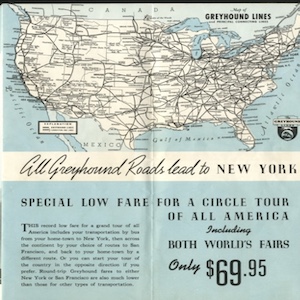Leisure, Travel and Mass Culture – The History of Tourism
Leisure, Travel and Mass Culture – The History of Tourism is an online archive of tourism resources, which allows students and researchers to gain a broader understanding of the cultural and social history of mass tourism, from the earliest travel agents of the mid-nineteenth century to 1980s. The resource brings together more than 4750 diverse primary sources from 15 international archives (such as California Historical Society, John W. Hartman Center at Duke University, and Thomas Cook Archives, etc.) including guidebooks, manuscript diaries, scrapbooks, correspondences, posters, advertisements, travel journals and tourist ephemera.
The site is beautifully presented and easy to access for users, with the menu at the top divided between "Introduction," "Documents," Galleries," "Explore," "Chronology," and "Help." Site navigation, collection overviews, and themes of the collection are gathered under the "Introduction" section. The documents in the collection arranged into themes, including road, rail, and air travel; the rise in popularity of beach vacations; health and medical travel, etc. Students can click on the appropriate tab to read short introductions on these major thematic areas and their significance to the history and growth of mass tourism.
The collections can be searched by keyword or by selecting the "Documents" section. Results may be browsed alphabetically or filtered by document type, libraries and archives, region, or theme. Each item has an explanatory page that includes the scanned images and a series of metadata of the sources. Among the ephemera available for viewing in the database are railway, shipping and airline advertisements, resort posters and guides plus promotional material for individual tourist attractions such as Blackpool’s Winter Gardens. Items in the collection come from around the world and are not just from Britain and the United States but also from Honolulu, Oahu and New Zealand, etc. They also include some items written in French, German and Spanish. The most important items are a series of Thomas Cook’s magazines: such as The Traveler’s Gazette and The American Traveler’s Gazette from the first half of the 20th century, all essential references for tourism historians.
The “Galleries” section provides photographs, illustrations, and maps, which highlights from the collection, it also indexed by key themes. It also includes some film compilations from the Thomas Cook archives and the Caravan and Camping Club, promoting Austria, coach tours of Switzerland and of the Italian Lakes. The most interesting section is "Explore" section, the "Interactive World Map" tab makes use of the digital platform to represent the history of mass tourism, which is particularly effective as a visual, interactive learning aid. A particularly useful tab was the "External Links," which links to external archival holdings and digital projects, to extend students' experience by providing more related information. The "Search Directories" tab provides a helpful starting point for those overwhelmed with the rich array of material; by navigating through this tab, users can narrow their searches through keywords and country/state, and more to guide their study. Finally, the "Chronology" section features of the site that offers brief information or factoids about a very diverse range of tourism-related events, the section is searchable in its entirety or may be filtered by region or theme. Individual entries may be saved to a list to create customized timelines according to users' research interests.
The site collects information that is large-scale, multilingual, and from multiple places across the world. The archival content provides insights into the relationship between the tourist industry and issues of class, gender, racial and national politics, by gathering all those documents, the site allows for unprecedented analysis related to those topics, which are suitable for historical research by high-school and college students. Students could explore the website and glean lots of information without traveling to distant archives and libraries. The site provides users with the ability to save items of interest they discover in their own personal file of documents and a Lightbox feature to create slideshows using the materials. Teachers thus could use the site to inform a lesson plan or lecture about how people in the past explored new environments and looked back on the experience for years to come. In sum, Leisure, Travel and Mass Culture – The History of Tourism is a fascinating collection of the evolution of travel. It offers a platform for interacting with primary source material, which is acts as a steppingstone towards further engagement with the archives. It also provides a useful starting point for students interested in developing case studies within this history.
